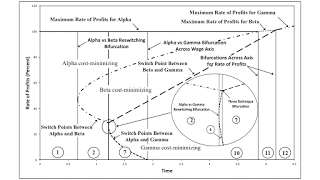Summary:
Variation of Switch Points with Technical Progress in Two Industries I have a new working paper - basically an update of one I have previously described. Abstract: This article illustrates the application of bifurcation analysis to structural economic dynamics with a choice of technique. A numerical example of the Samuelson-Garegnani model is presented in which technical progress is introduced. Examples of temporal paths through the parameter space illustrate variations of the wage frontier. A single technique is initially uniquely cost-minimizing for all feasible rates of profits. Eventually, the technique for which coefficients of production decrease at the fastest rate is always cost-minimizing. This example illustrates possible variations in the existence of Sraffa effects, which
Topics:
Robert Vienneau considers the following as important: Example in Mathematical Economics, Sraffa Effects, Towards Complex Dynamics
This could be interesting, too:
Variation of Switch Points with Technical Progress in Two Industries I have a new working paper - basically an update of one I have previously described. Abstract: This article illustrates the application of bifurcation analysis to structural economic dynamics with a choice of technique. A numerical example of the Samuelson-Garegnani model is presented in which technical progress is introduced. Examples of temporal paths through the parameter space illustrate variations of the wage frontier. A single technique is initially uniquely cost-minimizing for all feasible rates of profits. Eventually, the technique for which coefficients of production decrease at the fastest rate is always cost-minimizing. This example illustrates possible variations in the existence of Sraffa effects, which
Topics:
Robert Vienneau considers the following as important: Example in Mathematical Economics, Sraffa Effects, Towards Complex Dynamics
This could be interesting, too:
Robert Vienneau writes Austrian Capital Theory And Triple-Switching In The Corn-Tractor Model
Robert Vienneau writes Double Fluke Cases For Triple-Switching In The Corn-Tractor Model
Robert Vienneau writes The Emergence of Triple Switching and the Rarity of Reswitching Explained
Robert Vienneau writes Recap For A Triple -Switching Example

|
| Variation of Switch Points with Technical Progress in Two Industries |
I have a new working paper - basically an update of one I have previously described.
Abstract: This article illustrates the application of bifurcation analysis to structural economic dynamics with a choice of technique. A numerical example of the Samuelson-Garegnani model is presented in which technical progress is introduced. Examples of temporal paths through the parameter space illustrate variations of the wage frontier. A single technique is initially uniquely cost-minimizing for all feasible rates of profits. Eventually, the technique for which coefficients of production decrease at the fastest rate is always cost-minimizing. This example illustrates possible variations in the existence of Sraffa effects, which arise during the transition between these positions.
 Heterodox
Heterodox
